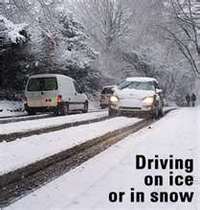Safe Winter Driving Starts with Vehicle Maintenance
 |
Bendix Brakes for Teen Safety Warns Drivers that Driving Safety Starts Before You Turn the Key: Winter Driving Hazards Amplify Alarm for Unsafe Vehicles
TROY, Mich., Feb. 17, 2012 - Forget your hat, and you risk cold ears on the way to school or work. Forget routine maintenance for your vehicle, and you risk injuring yourself, passengers and others on the road - a chance too many American drivers are willing to take at a time when road conditions are at their worst.
A recent Consumer Reports survey revealed that 40 percent of drivers are postponing car maintenance or repairs on their primary vehicle, with drivers 18 to 34 years old most likely to delay work on safety-critical wear items, such as brake pads or tires.
Although many consumers, especially teenagers, are trying to save money where possible, cutting corners on proper car care not only puts all drivers at risk for accidents or injury, delaying maintenance can actually cost more in the long run. In winter months, when inclement weather can wreak havoc on even the shortest commute to school or work, it is crucial that vehicles are in good working condition so that motorists arrive safely at their destination. Some maintenance, such as oil changes, brake inspections and tuneups need to be done by a professional; however, there is preventative maintenance that is simple and can be done by consumers in a garage or driveway.
Honeywell Friction Materials has developed Bendix Brakes for Teen Safety, a digital social media campaign to educate parents and teens of the importance of proper car care. Honeywell is reminding all drivers that poorly maintained vehicles can cause accidents, and offers the following tips for drivers to keep their vehicles safer on the road during these winter months:
* Braking systems are directly responsible for stopping your car. Squealing brakes are a sign that brake pads need replacing, while grinding noises are the sign of a much more serious problem. Both should be checked out by a certified technician immediately to prevent more damage and higher repair costs.
* Washington is the new Lincoln. Forgo the traditional penny and do a tire tread test with a quarter. If you can see the top of the general's head, it's time for new tires. Proper tread is essential in winter driving for maintaining contact with wet or icy pavement.
* Antifreeze is an essential part of your car's winter protection. Your car contains a 50/50 mix of water and antifreeze. Make sure the level is full and the mixture is accurate. If you are uncomfortable checking, a service center can do this for you.
* Visibility is critical. Wiper blades should be changed whenever you change your oil, with fluid reservoirs checked once a month during the winter driving season.
* Schedule routine vehicle inspections with a licensed technician - even the most experienced DIY-er can benefit from a second opinion.
"Wintertime driving is tough enough with a properly maintained vehicle," said Shannon Lara, Senior Manager, Marketing Communications for Honeywell Friction Materials. "Slick roads and poor visibility combined with neglected safety features creates hazardous driving situations. By arming drivers with proper car care tips and advice, we are hoping to promote safe driving habits that start before you even turn the key." Visit Bendix Brakes for Teen Safety on Facebook Bendix Brakes for Teens Safety or YouTube Bendix Brakes Videos for more information on getting teen drivers (and their rides) ready for winter.


